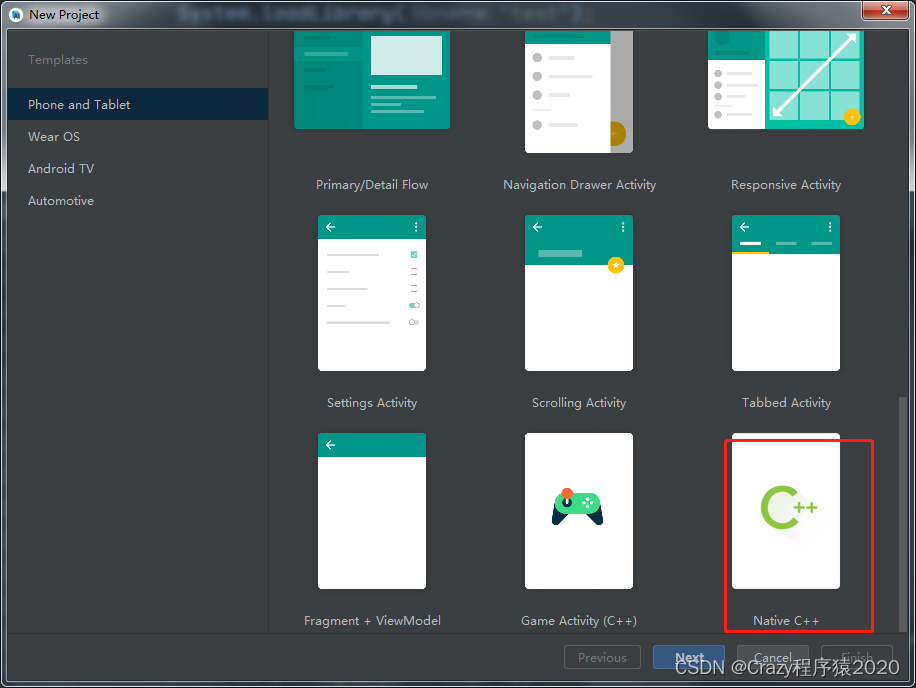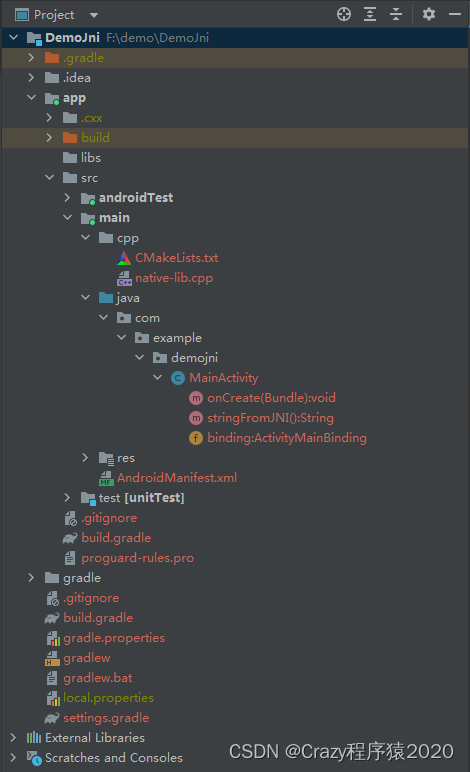一、简介
1. JNI 是什么
JNI 是 Java Native Interface 的缩写,即 Java 的本地接口。
目的是使得 Java 与本地其他语言(如 C/C++)进行交互。
JNI 是属于 Java 的,与 Android 无直接关系。
2. NDK 是什么
NDK 是 Native Development Kit 的缩写,是 Android 的工具开发包,也是Android SDK的一个扩展集,用来扩展SDK的功能。
作用是快速开发 C/C++ 的动态库,并自动将动态库与应用一起打包到 apk。
NDK 是属于 Android 的,与 Java 无直接关系。
3. JNI 与 NDK 的关系
JNI 是实现的目的,NDK 是 Android 中实现 JNI 的手段。
4、使用场景
- 1.为了提升这些模块的性能,对图形,视频,音频等计算密集型应用,将复杂模块计算封装在.so或者.a文件中处理。
- 2.使用的是C/C++进行编写的第三方库移植。如ffmppeg,OpenGl等。
- 3.某些情况下为了提高数据安全性,也会封装so来实现。毕竟使用纯Java开发的app是有很多逆向工具可以破解的。
二、注册方式
2.1静态注册
1. 定义
通过 JNIEXPORT 和 JNICALL 两个宏定义声明,在虚拟机加载 so 时发现上面两个宏定义的函数时就会链接到对应的 native 方法。
2. 对应规则
Java + 包名 + 类名 + 方法名
其中使用下划线将每部分隔开,包名也使用下划线隔开。
示例(包名:com.afei.jnidemo,类名:MainActivity):
// Java native method(java)
public native String stringFromJNI();
// JNI method (C++)
JNIEXPORT jstring JNICALL
Java_com_afei_jnidemo_MainActivity_stringFromJNI( JNIEnv *env, jobject instance);
如果名称中本来就包含下划线,将使用下划线加数字替换。
// Java native method
public native String stringFrom_JNI();
// JNI method
JNIEXPORT jstring JNICALL
Java_com_afei_jnidemo_MainActivity_stringFrom_1JNI(JNIEnv *env, jobject instance);
3. 优点
- 简单明了
4. 缺点
- 必须遵循注册规则
- 名字过长
- 运行时去找效率不高
2.2 动态注册
1. 定义
通过 RegisterNatives 方法手动完成 native 方法和 so 中的方法的绑定,这样虚拟机就可以通过这个函数映射表直接找到相应的方法了。
2. 注册过程示例
a. 假设有两个 native 方法如下:
public native String stringFromJNI();
public static native int add(int a, int b);
b. 通常我们在 JNI_OnLoad 方法中完成动态注册,native-lib.cpp 如下:
#include <jni.h>
#include <string>
#include "log.hpp"
extern "C" {
jstring stringFromJNI(JNIEnv *env, jobject instance) {
std::string hello = "Hello from C++";
return env->NewStringUTF(hello.c_str());
}
jint add(JNIEnv *env, jclass clazz, jint a, jint b) {
return a + b;
}
jint RegisterNatives(JNIEnv *env) {
jclass clazz = env->FindClass("com/afei/jnidemo/MainActivity");
if (clazz == NULL) {
LOGE("con't find class: com/afei/jnidemo/MainActivity");
return JNI_ERR;
}
JNINativeMethod methods_MainActivity[] = {
{
"stringFromJNI", "()Ljava/lang/String;", (void *) stringFromJNI},
{
"add", "(II)I", (void *) add}
};
// int len = sizeof(methods_MainActivity) / sizeof(methods_MainActivity[0]);
return env->RegisterNatives(clazz, methods_MainActivity,
sizeof(methods_MainActivity) / sizeof(methods_MainActivity[0]));
}
jint JNI_OnLoad(JavaVM *vm, void *reserved) {
JNIEnv *env = NULL;
if (vm->GetEnv((void **) &env, JNI_VERSION_1_6) != JNI_OK) {
return JNI_ERR;
}
jint result = RegisterNatives(env);
LOGD("RegisterNatives result: %d", result);
return JNI_VERSION_1_6;
}
}
c. 分析
如上,我们不再使用 JNIEXPORT 和 JNICALL 两个宏定义声明指定的方法,也不用依照固定的命名规则命名方法(不过通常 jni 里的方法名还是保持和 native 方法的方法名一致,见名思义),而是通过了一个 RegisterNatives 方法完成了动态注册。
3. RegisterNatives 方法解析
定义: jint RegisterNatives(jclass clazz, const JNINativeMethod* methods, jint nMethods)
参数:
- clazz:指定的类,即 native 方法所属的类
- methods:方法数组,这里需要了解一下 JNINativeMethod 结构体
- nMethods:方法数组的长度
JNINativeMethod:
typedef struct {
const char* name; // native 的方法名
const char* signature; // 方法签名,例如 ()Ljava/lang/String;
void* fnPtr; // 函数指针
} JNINativeMethod;
返回值:成功则返回 JNI_OK (0),失败则返回一个负值。
三、简单实践
4.1 新建Native C++工程

4.2 生成的代码工程如下

MainActivity.java代码
package com.example.demojni;
import androidx.appcompat.app.AppCompatActivity;
import android.os.Bundle;
import android.widget.TextView;
import com.example.demojni.databinding.ActivityMainBinding;
public class MainActivity extends AppCompatActivity {
private ActivityMainBinding binding;
@Override
protected void onCreate(Bundle savedInstanceState) {
super.onCreate(savedInstanceState);
binding = ActivityMainBinding.inflate(getLayoutInflater());
setContentView(binding.getRoot());
// Example of a call to a native method
TextView tv = binding.sampleText;
tv.setText(stringFromJNI());
}
/**
* A native method that is implemented by the 'demojni' native library,
* which is packaged with this application.
*/
public native String stringFromJNI();
// Used to load the 'demojni' library on application startup.
static {
System.loadLibrary("demojni");
}
}
native-lib.cpp 代码
#include <jni.h>
#include <string>
extern "C" JNIEXPORT jstring JNICALL
Java_com_example_demojni_MainActivity_stringFromJNI(
JNIEnv* env,
jobject /* this */) {
std::string hello = "Hello from C++";
return env->NewStringUTF(hello.c_str());
}
CMakeLists.txt
# For more information about using CMake with Android Studio, read the
# documentation: https://d.android.com/studio/projects/add-native-code.html
# Sets the minimum version of CMake required to build the native library.
cmake_minimum_required(VERSION 3.22.1)
# Declares and names the project.
project("demojni")
# Creates and names a library, sets it as either STATIC
# or SHARED, and provides the relative paths to its source code.
# You can define multiple libraries, and CMake builds them for you.
# Gradle automatically packages shared libraries with your APK.
add_library( # Sets the name of the library.
demojni
# Sets the library as a shared library.
SHARED
# Provides a relative path to your source file(s).
native-lib.cpp )
# Searches for a specified prebuilt library and stores the path as a
# variable. Because CMake includes system libraries in the search path by
# default, you only need to specify the name of the public NDK library
# you want to add. CMake verifies that the library exists before
# completing its build.
find_library( # Sets the name of the path variable.
log-lib
# Specifies the name of the NDK library that
# you want CMake to locate.
log )
# Specifies libraries CMake should link to your target library. You
# can link multiple libraries, such as libraries you define in this
# build script, prebuilt third-party libraries, or system libraries.
target_link_libraries( # Specifies the target library.
demojni
# Links the target library to the log library
# included in the NDK.
${
log-lib} )
4.3 运行结果

如果生成工程的时候有报错,按照如下解决(需要设置下JDK版本)
Android Studio Electric Eel提示Gradle插件报错问题的解决方法